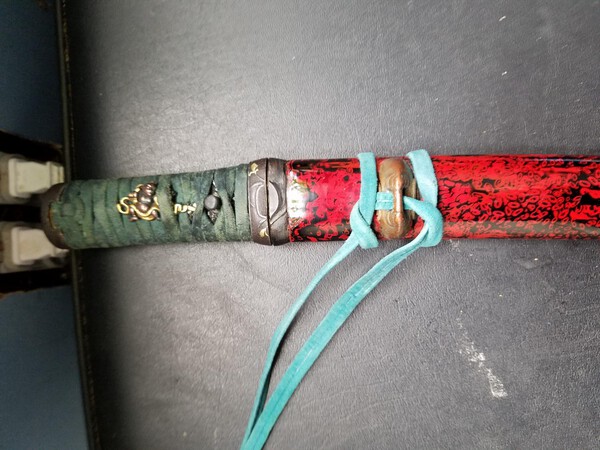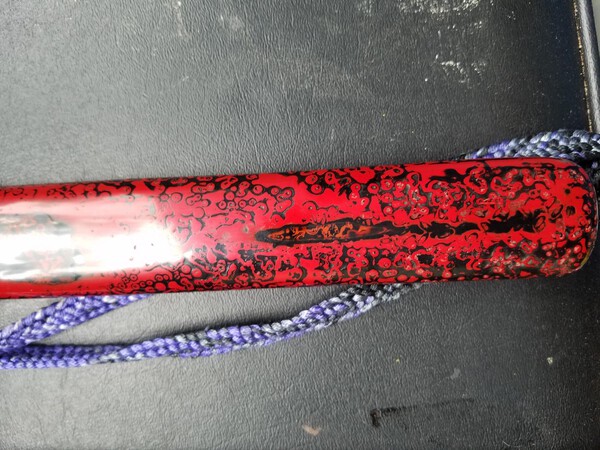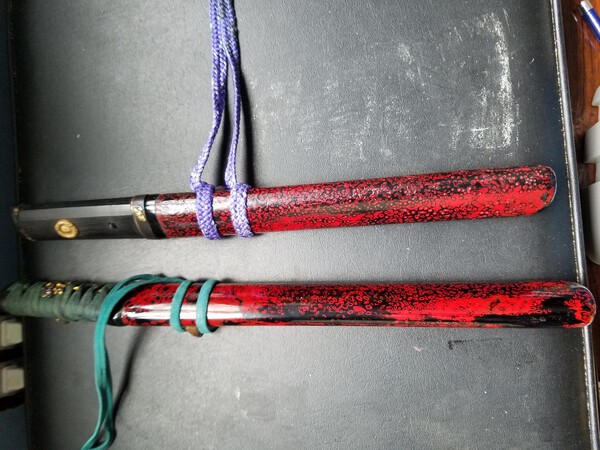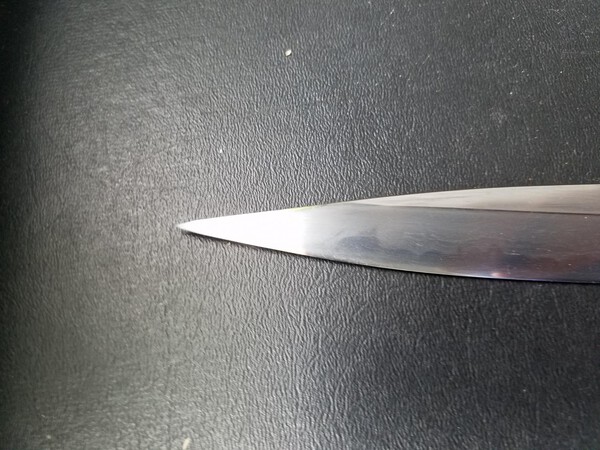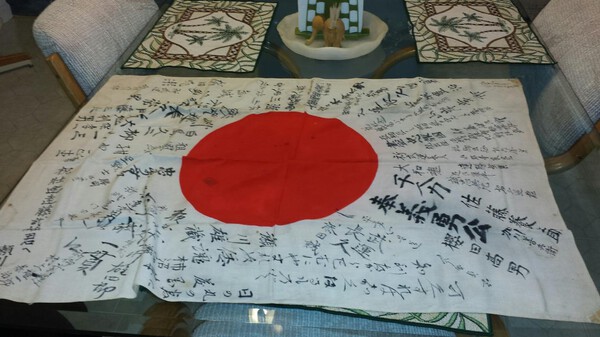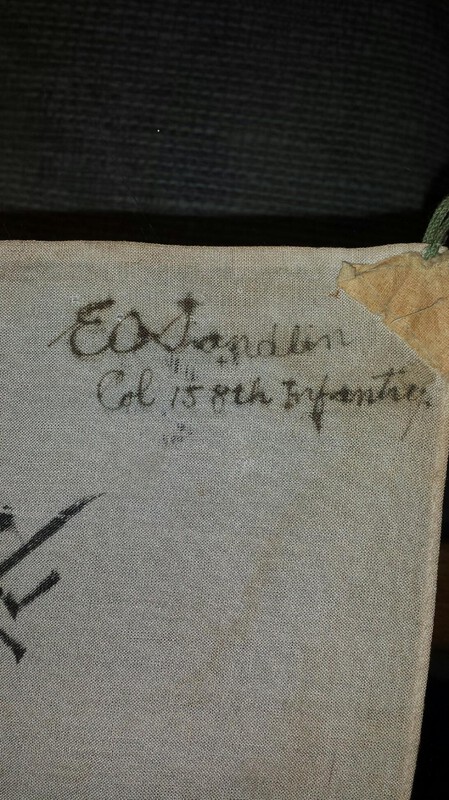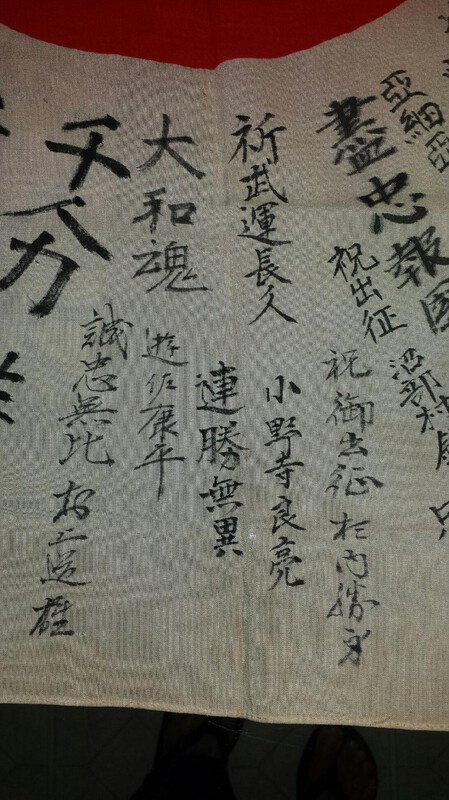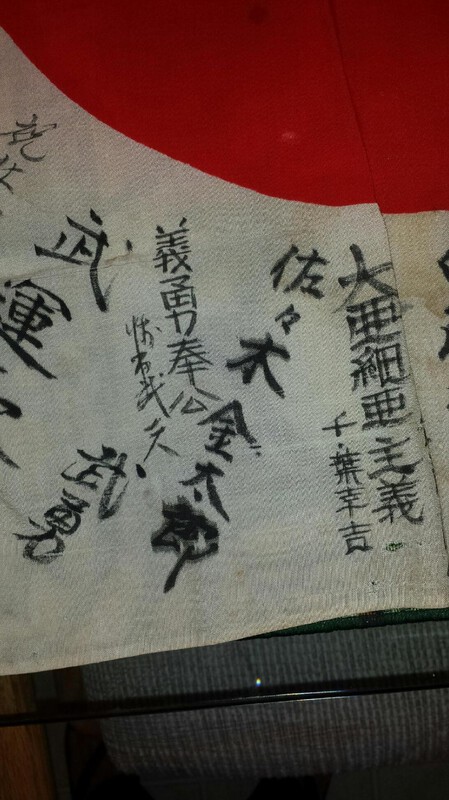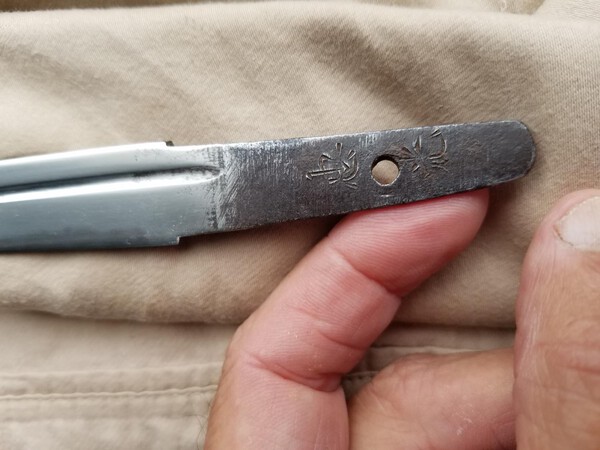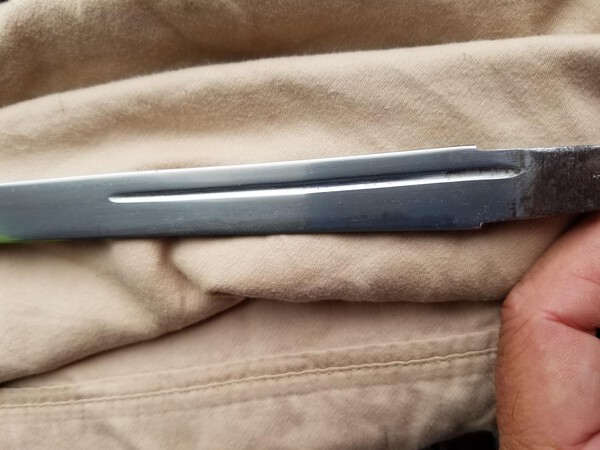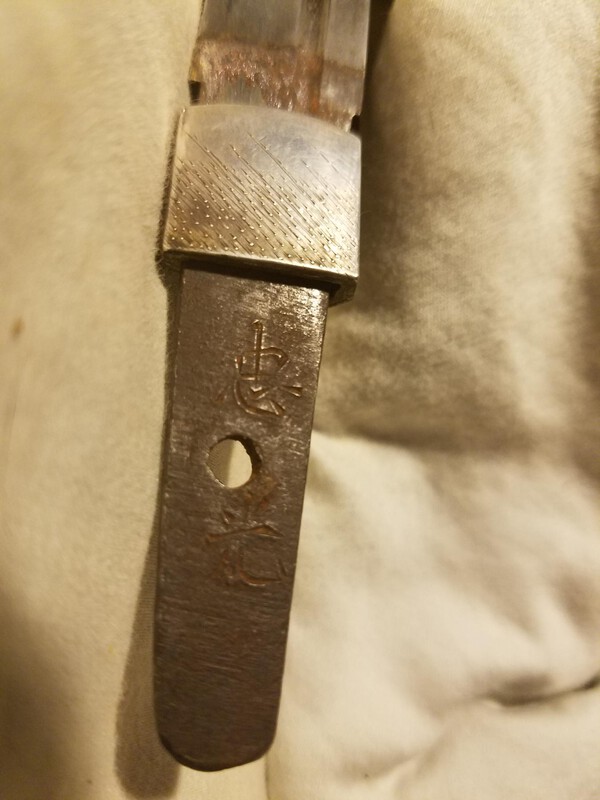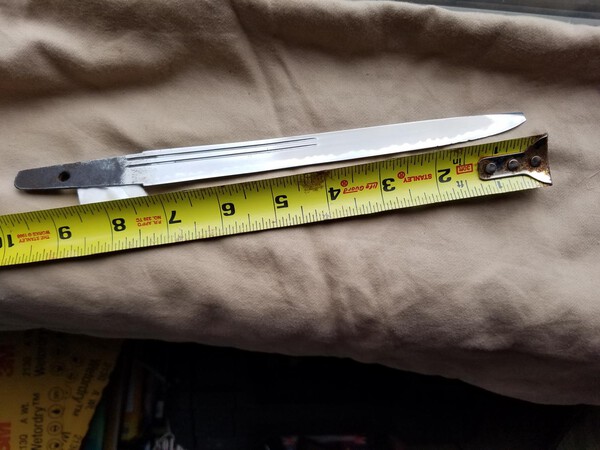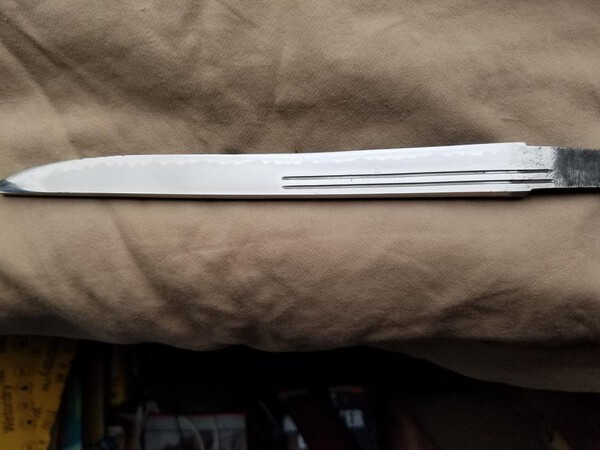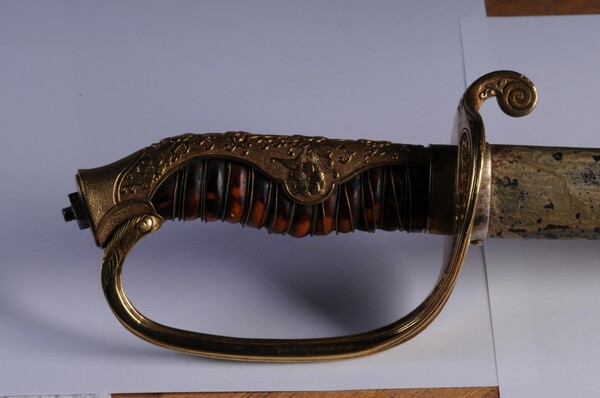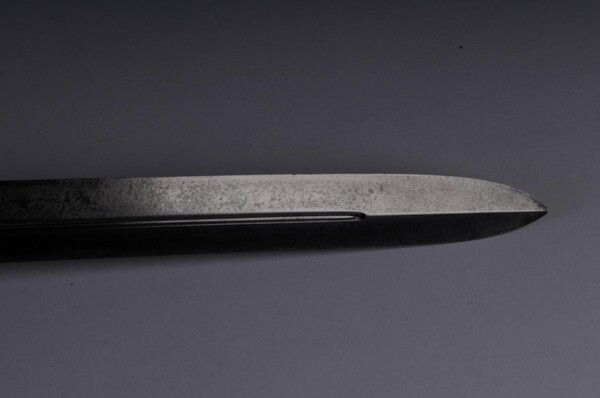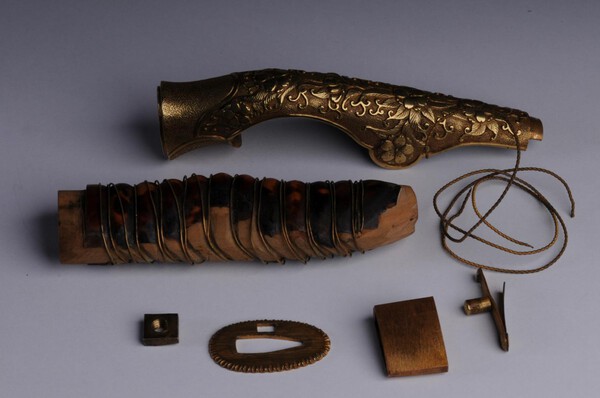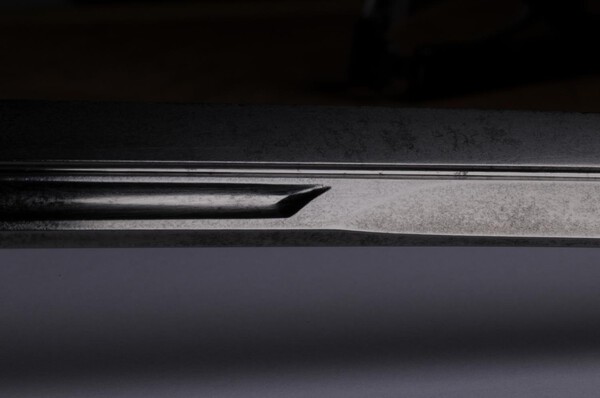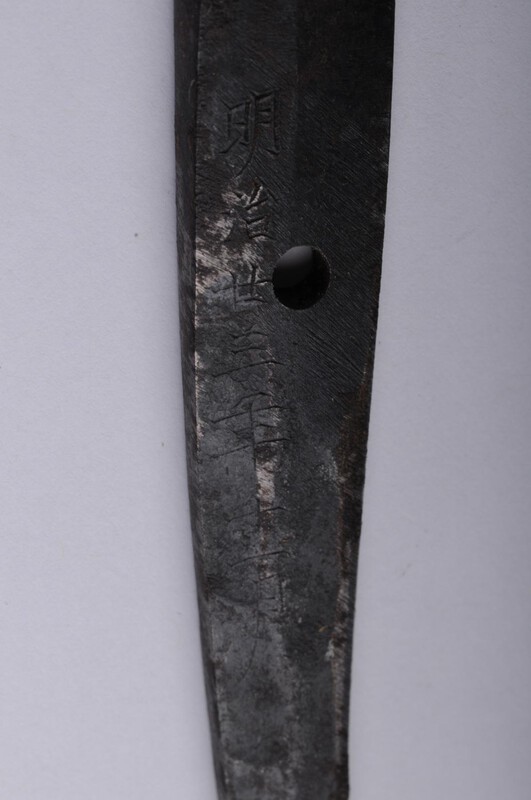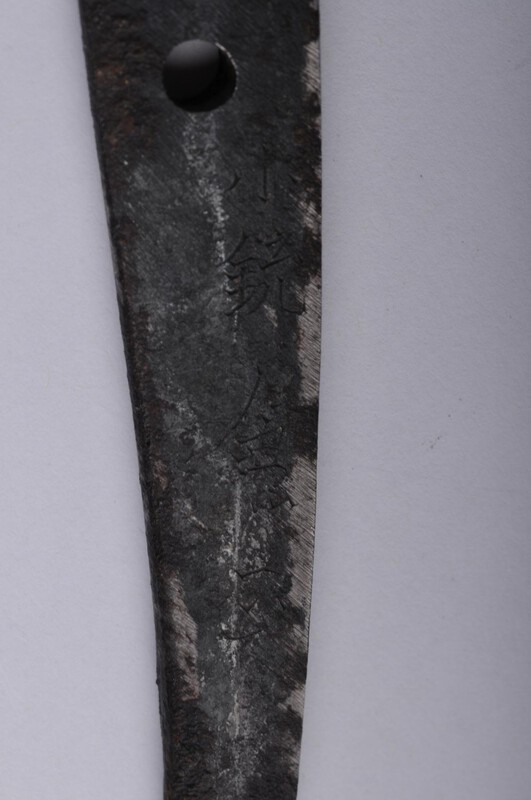
jct3602
Members-
Posts
171 -
Joined
-
Last visited
Content Type
Profiles
Forums
Events
Store
Downloads
Gallery
Everything posted by jct3602
-
2 tanto made out of a blade that was snapped in the middle (broken past the shinogi, then someone attempted to hammer it back together). They probably thought they could cut a tree down or something akin to that. A great deal of the furniture was made by the gentleman who cut the blade down (the o-suriage and the satsuma-age), also the laquering and the tsuka. The menuki, one kurikata, and one fuchi were from collections; habaki, tsuka, etc. were all made. Took almost 8 years, but was worth it. Yours, john twineham
-
Started with a blade that had been split past the shinogi, and then sort of hammered (some American probably showing how he could slice a tree in 2). A friend did all the work, cutting, shaping, tang, Laquer, tsuka, etc. Everything but the menuki, the ganesh kurikata, and one fuchi. The base was Satsuma-aged and ended up looking like a yoroi-doshi. Sending some pictures now, and more as i get them transferred to computer. Hope they are worth viewing, lol. yours, john twineham
-
My understanding is that many of these flags were inscribed at a kind of going away party when the unit was being deployed. Any one have any other information on when these were done? john twineham
-
pictures as promised - also there is a second flag, fewer signatures and in much worse condition. yours; john twineham
-
Found this in family stuff at my sisters. Signed in upper corner by a colonel in the 158th regimental combat team (Bushmasters), my father's unit throughout the war (Panama-New Guinea-lots of islands-Philippines-occupied Japan). Thought it might be interesting, will add some pictures in a couple of minutes. john twineham
-
Do not know what topic they fall under, but came upon 2 rising sun flags that my father brought back at the end of WW2 (he was a career army officer). One has a notation in the upper corner near one of the 2 leather triangles that the flag was flown, written, with his name, by a colonel in the 158 Regimental Combat Team, my fathers unit. They both have the typical signatures radiating out from the sun and the better condition one has a number of other signatures filled in where there was room. The more tattered one looks like it might have seen some action. Anyway, just seemed interesting, since they have some family provenance. Found them when visiting my sister cross-country; she is sending them to me since i forgot to load them in my luggage, so will have pictures sometime soon, if anyone is interested in seeing photos. yours, john twineham
-
Alex, thanks for the "kuwana" refernce in ksky (I love reading his stuff on the internet; poor English, great knowledge and outstanding enthusiasm). Excellent speculation! yours, john twineham
-
Hi Barry - pointed out the delamination to Michael Bell and he said it was not bad at all; In real viewing terms it is practically invisible (the blade is so small!) Your comment on the tip mirrors my thoughts. I will show you it in the Burlingame Token-kai in August, since I believe you are usually in attendance. No interest in selling it at all, so no problems there. Including a picture of the larger hi and nakago in perspective. yours, John Twineham
-
Might as well show the nakago and nijimei, lol. You can see from the filing and crispness of the mei why i have my doubts. john twineham
-
More pictures - They are gomabashi I believe. 1st picture is contrasted and hued up to show boshi shape more clearly; 3rd picture is the same picture before fiddling. Significant piece of tip is gone but Michael Bell has seen it personally and says repair would be no problem (I am not so sure!). 2017607_182102 is the original of 20170608_030548. Single larger half length hi on opposite side from pair; adding a slightly older picture with a contrasted and hued edition of same picture (2017608_175458 and 175552) of the upper area of the side with single hi.
-
-
Found this tanto in items stored away after my mother passed away. She picked it up around 1949 in Japan; think it has a gimei nijimei. My opinion is a good shinshinto copy of mid koto Bizen work, but who knows? The habuchi is clear and even, the tani, particularly near the hamachi, are deep and contain dense nioi. Picture taken with Samsung 7 in indirect early morning light. Will try to provide more pictures if anyone is interested. Blade edge about 19cm, kurijiri nakago with kiri yasurime, but a few diagonal file marks under the habaki. Did not provide the gimei? signature to eliminate possibly influencing preconceptions. Any speculation would be appreciated. Thanks, john twineham
-
Hi, John Stuart: Thank you - believe you are correct. Never thought of the Mt. Fuji formation as a periodically recurrent motif; it would seem to fit with the mei. Am trying to get an add-on lens for the Samsung 7 which allows ultra close-ups; perhaps then better pictures than teasers can be provided. Yours, john twineham
-
For John Stuart: More pictures, but given the file compression involved (this site appears to use a 20-1 ratio) and the inadequacies of my new camera (had a 16MP Samsung 6; went to the Samsung 7, it has a lot of improvements, but they dropped to a 12MP dual mode camera to help catch moving images; sadly it does not come close to the fine detail that the 16MP had. Would not have thought there would be that much difference). Also, the blade is very tiny - motohaba is 2.0cm and sakihaba is 1.45cm with a 1.75cm kissaki, so the details in the pictures are relatively tiny. The width from the edge of the ha to the shinogi in these pictures is around 1.3 cm at most. As for the MT. Fuji possibility, the opposite side of the blade has something similar to "Mt. Fuji in clouds", which I will include. The signature is either gimei or daimei; purports to be Tanba no Kami Yoshimichi of the Mishina schools. Can find no generation of Tanba no kami Yoshimichi that matches the chisel strokes (also no kiku mon), so hopefully will find someone at the Burlingame Token Kai who can help me out. Yours, john twineham
-
(1) Are the protrusions towards the ha considered ashi or something else? (2) Is the whole formation some particular form of Shinto "created" hamon, and if so, what is it's name? Thanks, john twineham
-
Sorry about the last pictures; file compression make them useless. Yours, john twineham
-
Hi Grant - Would be great to meet you. As for the signature, it is Tanba no kami Yoshimichi, but my feeling is a daimei, since i can not match some portions of the signature to any examples i have found, but the work is very good and has many characteristics of the Tanba school (could also be gimei, of course). The hamon is in ko-nie deki, with spots of nioi kuzure inside the hamon and two areas with extensive nie kuzure making the hamon in those areas not very distinct. Some areas are showing extensive but light sunagashi, plus a prototypical "Mt. Fuji in clouds". There is also a formation which has the same ordering as the "dragon chasing a tama"; a tobiyaki separated from an almost tobiyaki with a tail trailing towards the nakago from it. The nie kuzure makes me wonder about the quality, but the very tiny ko-nie throughout and lots of ji-nie gives the opposite impression . If it is daimei, would like to discover the actual smith; if gimei, would like to have that removed and the nakago repatinated (Despite common opinion that creating a good age patina so that it can not be differentiated from a real one is impossible, i know someone who can and has). A few more pictures, but getting accurate photos of activity is very tough, and with file compression, etc. oh well. Yours, john twineham
-
Early Murata-To, And How To Id Them
jct3602 replied to lonely panet's topic in Military Swords of Japan
Thierry, Many thanks! Yours, john twineham -
Early Murata-To, And How To Id Them
jct3602 replied to lonely panet's topic in Military Swords of Japan
Hi Jean - Your recommendation for Ohmura is excellent. Do you have some way of finding a log of the topics in his works? I have taken the http://ohmura-study.net/and substituted various numbers after the net/ and before the html and accessed various items of interest. However, it is not a very skillful way of doing things, lol. Yours, john twineham -
Hi Grant - Some pictures of the nakago and the blade when i first acquired it. The kodachi possibility was not an added on tang, but it is true that something causing loss of patina has been done, and the signature appears to be gimei or perhaps daimei. It does seems to be illogical to add a tang with a poor signature and damaged patina. I did not show the saya, since it is not finished yet. The restorer will hopefully have the lacquering repair finished by the Burlingame token-kai. He restores lacquering on writing boxes for the Portland museum, so he is quite good; however, it takes steady warmth, high humidity, and about 2 weeks for each layer to set (plus top lacquer is expensive; $30 a tube from Namikawa-Heibei). Since you are from California, if you are attending the Token-Kai stop by the Stephen Strauch table and you can take a look yourself; I am sharing the table with him.
-
Early Murata-To, And How To Id Them
jct3602 replied to lonely panet's topic in Military Swords of Japan
Hi - Have an example, was in general's mounts with tortoiseshell, D-guard, gold-washed wire, etc. However, it seems to have no hamon, or possibly an ito-suguha that just is not coming out very well. enclosing pictures. Has both signature and date mei, but not one of the standard mei for Murata-to. No armory stamp or production number, and date is very early for the Kogerasu-Maru style blades. Hope this is the type of stuff what you were looking for, Yours, john twineham -
-
Hi Geraint The sword is ubu, as far as i can tell, and has a signature which i think is either daimei or gimei. Enclosing some pictures made from my cellphone of the furniture (with the caveat of the effects of file compression on the quality of the pictures). The repair of the saya is about 50% complete, but will add some pictures next post. Also, If you wish, can send pictures of the hamon, etc., but would like to get some opinions on the blade before opinions are influenced (or not) by the questionable mei, so that picture will be later. Will also send pictures of the unsigned side to show nakago shape and yasurime. Thank you for your thoughts, john twineham
-
Ken, who is the author that you are quoting for your information? I know that information falls under "common knowledge", but have you read Nakahara's book? The quote from page 61 is "to define the correct curvature of a tachi, a line should be drawn from the very butt of the tang to the tip of the sword...Currently, swords are measured by using a line from the back end of the sword (munemachi) to its tip... This kind of measurement is only used for sword licensing."
-
Ken, the sori measure was from tip to the munemachi. However, according to Nakahara, the measurement to the end of the nakago is in fact correct (page 61, facts and fundamentals...), not the one i used. Maximum sori from tip of kissaki to the upper end of the mune is 1.55cm. Including picture of some of the furniture Thank you for the clarification, John


